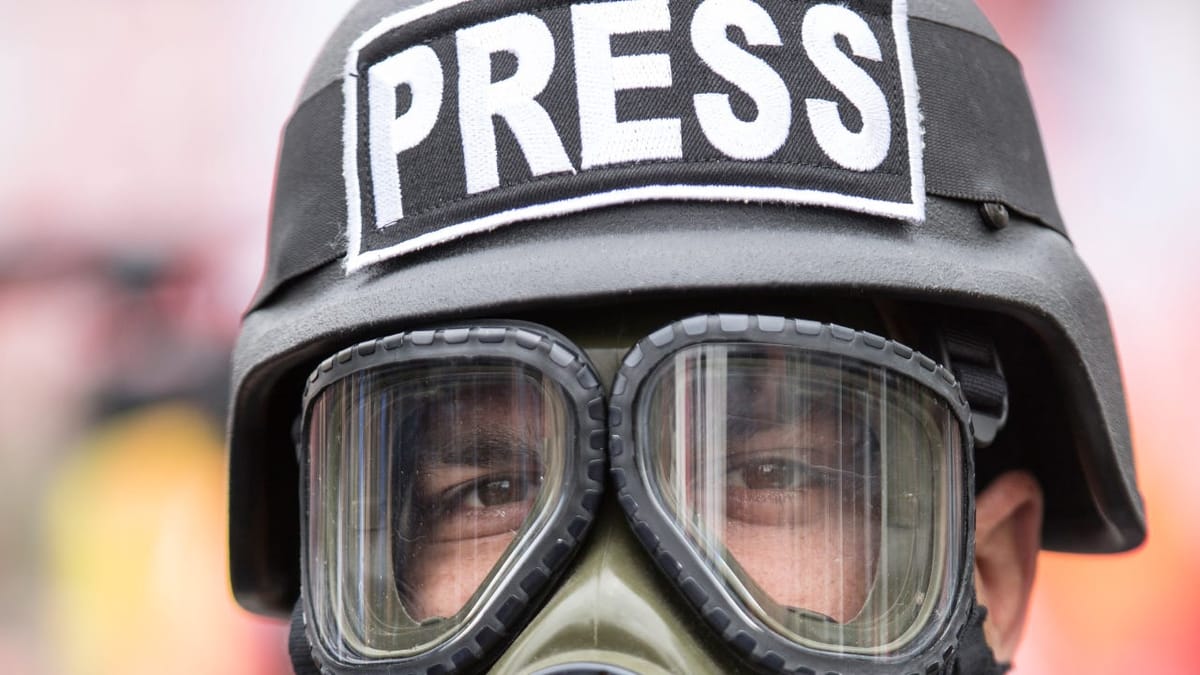Can Journalism Truly Be Anti-fascist?
While far-right attacks on journalists escalate, news media's interests lie elsewhere

Canadian journalists are under sustained attack from the fascist right.
This has been happening for years, but the early 2022 convoy occupation in Ottawa emboldened them to drastically escalate their harassment campaigns. The primary targets are women, and especially women of colour. Rachel Gilmore, a reporter for Global News who covers extremism, has been a favourite subject for the hate campaigns. These include emails consisting of threats of graphic violence, as she elaborated in a TikTok. Though Gilmore has been the most visible target, she is far from the only one. Other journalists primarily targeted are Toronto Star Podcast host and producer Saba Eitizaz, whom received five emails containing violent threats, and Hill Times columnist Erica Ifill.
Unfortunately, this trend isn’t new. The Toronto Star released a story in September of this year that delved into the issue, covering these three same journalists. Nora Loreto, an independent journalist who has also been on the receiving end of harassment campaigns, penned two articles for Passage on the subject around the same time. The first gives an overview of how solutions have stalled on the situation, while the second focuses specifically on how reporting this harassment to the police is not the solution. All of these are fantastic pieces.
Escalating rhetoric against journalists
The rise in violent threats towards journalists is not limited to Canada. Fascist rhetoric against news institutions and the journalists who report for them have become disturbingly radicalized in recent years. Trump’s refrain of “fake news” for every report that was remotely critical of him is widely known, but what often goes under-reported is its chilling effect. In 2018, Reporters Without Borders announced that the USA had become one of the deadliest countries in the world for journalists. Reporters covering the 2020 George Floyd protests were routinely attacked by police, with some being arrested live on-air. Katherine Jacobsen, Committee to Protect Journalists’ regional program director for United States and Canada, put it succinctly, “There’s no better way to control coverage than to make sure that it’s not possible to cover something safely in the first place.”
In the time since, fascist attacks on journalists have become more brazen and widespread. Trump’s ouster as President has led him to publicly fantasize about journalists being thrown in prison and raped for not revealing sources. Italy’s newly elected fascist Prime Minister Giorgia Meloni consistently sends her supporters after critical reporters. Viktor Orban’s fascist “illiberal democracy” openly muzzles them to prevent critical coverage.
Though federal Conservative leader Pierre Poilievre hasn’t been as explicit as Trump or Meloni with his attacks on journalists, he’s happy to direct harassment towards them. Poilievre also directly targeted Gilmore, who asked him about his ties to James Topp and Diagolon, calling her a “so-called journalist” and Global News a “Liberal mouthpiece.” A fundraising letter told supporters they were up against the media “who are no longer interested in even pretending to be unbiased,” and said “They want us to lose.” Of course when prominent members of Diagolon went on to threaten sexual assault against Poilievre’s wife, he condemned them immediately.
Fascism and News Media’s Sordid Relationship
The frustrating reality about this dynamic is that the news industry itself has historically been a willing partner in fascism’s progression. Of course, it’s a known fact that fascists seize and their nation’s press when they come to power. Mussolini’s rise in 1922 was quickly followed by “velines” sent out to press organizations, which directed what could and couldn’t be covered by reporters. When the Nazis rose to power in the 30s, they spread fear of communist uprisings to justify seizing media outlets.
However, neither of these things could have been done without years of sympathetic coverage by large news organizations in some form or another. In Michael Parenti’s book Blackshirts and Reds he writes about favourable coverage of Mussolini coming from “Fortune, the Wallstreet Journal Saturday Evening Post, New York Times, Chicago Tribune, and Christian Science Monitor.”1 Meanwhile, after Hitler was released from prison for his role in the Beer Hall Putsch, the New York Times ran a headline that read “Hitler Tamed By Prison.” The Saturday Evening Post even serialized Mussolini's autobiography in 1928.
The Conversation elaborates on positive news coverage Mussolini and Hitler received in further detail. Once fascism had entrenched itself in Europe, US press lauded their regimes for stemming the tide of communism on the continent, "From their perspective, the post-WWI surge of anti-capitalism in Europe was a vastly worse threat than Fascism." Parenti notes capitalist news magnates were only happy to provide cover for the Nazi government, “William Randolph Hearst instructed his correspondents in Germany to file friendly reports about Hitler's regime. Those who refused were transferred or fired.”2
This dynamic has sadly continued in the 80+ years since Mussolini and Hitler’s ascension. Noam Chomsky, author of Manufacturing Consent, investigated the lack of coverage from legacy media concerning right-wing state attacks on the press in countries like El Salvador. The media’s reporting on Trump’s 2016 Presidential bid amounted to billions of dollars in free coverage. Simply type the words “antifa” and “clash” into Google to see how media covers anti-fascist community responses with neutral, equalizing language. The latest right-wing coup in Peru is framed as having an “accidental president” after leftist president Pedro Castillo’s “power grab.”
Beyond the more subtle tactics for laundering fascism, there have been much more explicit decisions. Canadian media outlets have been especially focused on downplaying the Ukrainian Azov Battalion’s explicit Nazi ties since the war in Ukraine began. In one instance, The Globe and Mail uncritically platformed a prominent Azov Lieutenant-Colonel’s wife saying “They are not Nazis,” without mentioning that they are, in fact, largely Nazis.
The reason for this becomes clear when examined materially. Eric Alterman, writing for The American Prospect, examines the corporate influence subduing proper coverage of fascism. From the Murdoch press elevating far-right voices to vulture capitalists buying up and decimating local journalism outlets, as Alterman writes, the issue is systemic and multi-faceted. He also examines the false pretense of a “both sides” approach to all issues. A method that inevitably benefits the far-right.
How can you show you are being “fair” to “both sides” if you consistently point out that just one of them is lying to you and doing so to destroy your country’s democracy? It may be true, but it sure doesn’t sound as if you are reporting the news in unbiased, “bipartisan” fashion.
Though Alterman makes crucial points, the entire dynamic is emblematic of the news media operating as a propaganda arm for capitalism. By equally weighing the liberal and conservative wings of capital, while eliminating any further left voices, the validity of dangerous rhetoric is affirmed. This false dichotomy completely excludes the left, elevates the right, and aligns with corporate interests. As Parenti writes in his book Inventing Reality: The Politics of News Media,
The centrist media is, in a word, more receptive to the right than to the left because its owners and corporate heads share the right's basic feelings about free enterprise, capitalism, communism, labor unions, popular protest, and U.S. global supremacy.3
The simple truth of the matter is that fascism doesn’t threaten capitalist business interests. To the contrary, in most cases it promotes them. As Professor Germa Bel wrote in a paper at the University of Barcelona, Nazi privatization reached new heights during the 1930s not achieved by other capitalist countries, who had stronger labour unions to stem the hemorrhaging of public services. This tactic of privatization has been a fixture in fascist politicians since. In military dictator Augusto Pinochet’s Chile, neoliberalism was tested and implemented at the behest of Milton Friedman and his Chicago Boys. Pinochet’s regime conducted a reign of terror against suspected leftists, torturing and disappearing countless people in its wake.
The connection is clear: the interests of the business class and the methods of fascism are one and the same: destroy the left, crush workers rights, and eliminate any form of resistance.
Watching the Watchmen
Despite capitalist news media facilitating the rise of far-right movements and figures, fascist figureheads and movements target journalists who cover their activities. That’s because the class divide between the ownership and working class permeates through news rooms. News agencies in the global north are either owned and operated by profit-oriented businesses, or by states that have an invested interest in reporting on stories that adhere to certain capitalist frameworks. Conversely, the journalists targeted by fascists are closer to the working class, even if their reporting within these systemic confines doesn’t typically reflect that class character.
Consider the average wage of a journalists. In 2019, those working in news media were encouraged to self-report salaries and their industry positions in a publicly available Google doc. While the pay certainly appeared above $100,000 in certain positions and cities, most ranged between $30,000-$80,000. This doesn’t include key anchors like Anderson Cooper or Fareed Zakaria, who certainly make much more in their position. Though this particular document is three years old and self-reported, the trend is indicative that a great deal of journalism is done by those who don’t get make a six-figure income.
Beyond this, consider the political positioning of news media corporations as a whole. To illustrate a distinct right-ward narrative in particular companies is not difficult. In 2018, Canadaland reported an internal memo from the Toronto Sun highlighting their strategy to attack the Ontario Liberals, leading the way for the Progressive Conservative party to win the election. This memo directed the company to attack the Liberal Party, stating “this government practices race, gender and sexual politics for ideological and political gain.”
Additionally, Canadaland also chronicled the National Post’s distinct right-wing shift in a 2019 long-form investigation on the subject. The piece interviews current and former employees and highlights directives from editors that paint a distinct right-wing shift. “What has happened… is that Postmedia has given a directive from all of its papers to shift to the political right, in an unprecedented, centralized fashion.”
Meanwhile, state-affiliated media like the CBC toe the line of Canadian governmental policy. In 2021, two journalists were told they couldn’t cover Israel-Palestine after signing an open letter asking for improved coverage. Pacinthe Matter’s piece in The Walrus discusses multiple instances of increased scrutiny of her reporting on marginalized issues that her white colleagues didn’t face. In one case, an editor demanded proof of an interviewee’s name during the 2015 Freddie Gray protests in Baltimore that Mattar covered, which she didn’t face anywhere else in her reporting. In another, an interview with journalist Ahmed Shihab-Eldin about Israel’s treatment of the al-Aqsa mosque was stopped by management for dubious reasons. These mirror Canadian governments’ inaction on issues with policing, and their position on Israel.
Broadly speaking, this is a trend of the news media industry as a whole, but there are absolutely individual journalists who continue the work of fascists, consciously or otherwise. Famed fake-British-accent-haver Andy Ngô finally admitted he knows his following uses his Twitter feed to target activists. The Ottawa Police sympathized with the convoy, and used Rex Murphy columns to justify their lack of action. Adam Zivo’s July National Post column fear-mongering over crime in unhoused encampments was followed two days later by a man hunting down unhoused people in Vancouver. Despite this, he continues to write columns on the same topic.
But beyond the blatantly right-wing organizations and individuals, even centrist and liberal outlets operate under an uncomfortable reality: there is incentive to continue operating in the current manner. As mentioned earlier, news media provided Donald Trump with billions of dollars in free coverage, but news media also suffered after Trump left the White House. From October 2022 to October 2021, Forbes reported that television news companies faced a significant drop in ratings. This included Fox News (-53 per cent), MSNBC (-56 per cent), and CNN (-76 per cent). Though news corporations were never left-wing in any meaningful sense of the word, difficulties in funding since the dawn of the internet have shifted interests decisively to the right. This includes the past decade’s acquisitions in news companies by hedge funds and billionaires.
Boxing out the left, promoting business interests and platforming fascists means more money for owners, regardless of the effects it has on the lower-rung of journalists who face the consequences.
What Is to Be Done?
This analysis should not be construed to imply that the targets of fascist harassment have in any way caused their suffering. Gilmore, Ifill, Eitizaz and countless others targeted by the fascist hordes are not to blame for this system, which sits outside of any individual control. But to properly confront this rise in violent harassment, a systemic analysis is necessary to pinpoint the problem.
News media and capitalist society as a whole have been key in enabling fascists to become emboldened and powerful. Some of the victims of these consequences are the rank and file reporters who do necessary work, marginalized people as a whole and anyone who merely names the problem for what it is. Those who facilitated this rise, including the news media, politicians, the capitalist system and the police who pretend to be helpless, are largely assumed to be outside of the dynamic.
There are, however, actions that journalists can take to slow this process and push back against the systemic propagation of fascism.
“Antifa” has become a demonized concept in our society, attacked by the media and right-wing politicians as a threat to be feared and despised. But journalists are being targeted because they cover fascism, while dissecting its roots and effects in an attempt to stop it. Anti-fascism is not just punching Nazis (though that certainly helps), it includes de-platforming, overwhelming demonstrations with counter-protestors and exposing their beliefs to friends, family and their work place. Reporting on fascists constitutes or facilitates these effective methods of anti-fascism. If it didn’t threaten fascism, the journalists who do this work wouldn’t be targeted as vigorously as they are.
Mark Bray, researcher and author of Antifa: the Anti-Fascist Handbook, describes the concept of everyday fascism and everyday anti-fascism in his book. Elaborating on this tactic, Bray writes: “[T]he goal of everyday anti-fascism is to increase the social cost of oppressive behavior to such a point that those who promote it see no option but for their views to recede into hiding.” Journalists should push for their profession to adopt this philosophy in their reporting. Doing this would begin to properly combat the factors that led to where we are today.
This isn’t just an abstract approach, there are concrete ways that this can be done. Publications should include a working definition of fascism drawn from scholarly and historical research displayed prominently on their websites, with strong citations and consistent usage in reporting. Outlets should stop the use of words like “racist” solely in quotes. Reliance on police narratives in general must be reduced and police statements should be fact-checked in every instance they are used. Every story concerning the subject of fascism or fascist figures should consult anti-fascist scholars. Further to this, subjects with ties to fascist figures and organizations should always be noted and explained in detail. Crucially, favourable or “neutral” coverage of fascists should be eliminated, de-platforming their ideas completely.
This approach is backed up by research. Assistant professor of Communications and Media at Stanford University Andrew Fitzgerald wrote a paper on the news media’s role in Weimar Germany compared to modern reporting and came to the conclusion that press should take a partisan stance to push back against fascism. In particular, Fitzgerald notes that refusing to take a stance hastened liberal democracy’s collapse, “the speed with which the liberal Weimar press dug its own grave (along with millions of others) through weak-kneed ‘wait and see’ moderatism or outright sympathy for the nascent fascist politico-cultural apparatus is telling.” More specifically in the modern context, Fitzgerald explores tactics of partisanship that news outlets like Buzzfeed, The Times-News and The Intercept employ to push back against bigotry and hate.
[B]eing partisan or interested is not mutually exclusive from reporting facts—it just jettisons the triangulation between “both sides” due to the mantra of objectivity, and obsession specifically with facts. But I would also add that this partisanship must also be coupled with a broader systemic or structural critique of journalism, its notions of engagement and participation in the emerging political economy, as well as more expansive social and political projects aimed at these concepts in the broader sociocultural and political context of both the discursive and the material world.
While these solutions and approaches must be pursued, it must be made clear that if the class character of news media is not taken into account, a full rectification cannot be made. It’s important to note that any politician or institutional figure that would cry foul at implementing anti-fascist methods will do so regardless of their implementation. As such, this should not be used as an excuse for inaction.
No divide necessary
Since the demonization of the term has entrenched itself in public discourse, there’s an inherent hesitancy for some in proclaiming they’re anti-fascist. However, for those who feel the distinction is important, being anti-fascist does not make one a leftist. Though the realm of organizing and spearheading anti-fascist actions and tactics has historically belonged to the left, anti-fascist activists have ranged anywhere from the most ardent communists, to liberals and even to conservatives. One doesn’t need to be Georgy Zhukov to consistently practice anti-fascism in their life, and while much theory and work has been done to illustrate the connection between capitalism and fascism, one does not need to be bound by that relation to work against fascists.
However, while this is strictly true, it’s still necessary to note that journalism as an industry was born out of capitalist states. These same states have historically used fascists and their brood to enforce rigid imperialism. The news media’s role in the propagation of settler-colonialism must also be acknowledged. News companies in Canada and the USA are both based in resource-extractive states built on enforced racial hierarchies. The method of colonialism and genocide achieved using Manifest Destiny and the westward expansion informed Hitler’s concept of lebensraum. In order to build structures to protect journalists targeted by fascism, the material reality behind its propagation needs to be recognized and combated.
Still, a change in the foundational make-up of news media must be conducted if the threat of fascism is to be beaten back and defeated. Journalists like Ifill, Gilmore and Eitizaz are keenly aware of the dynamic between fascist rhetoric and violent harassment, but every journalist needs to take a stand in their reporting. News media must also acknowledge its role in allowing and facilitating this behaviour. Journalists who belong to protected classes specifically should be committed allies and lead this charge, as they will inevitably face less backlash than journalists belonging to marginalized groups.
If no methods are implemented to push back against fascism’s rise, the issue will only intensify. Journalists, targeted groups and public safety are all at risk. News media cannot continue in its current form if they seriously hope to combat the rise of the far-right. As we’ve seen historically, the price of action is far lower than the price of inaction.
Parenti, M. Blackshirts and Reds, (1997), City Lights Publishers; First Printing, Notations edition. p.10 ↩
Parenti, M. Blackshirts and Reds, (1997), City Lights Publishers; First Printing, Notations edition. p.11 ↩
Parenti, M. Inventing Reality: The Politics of News Media, Second edition (1992), Wadsworth Publishing p.107 ↩




Comments ()